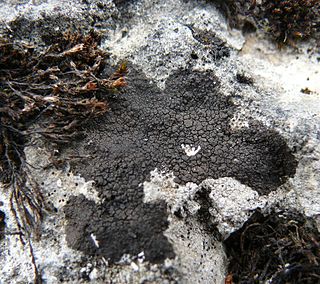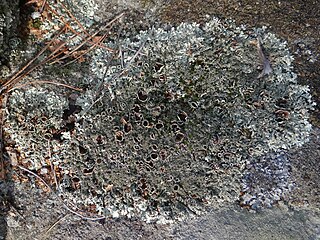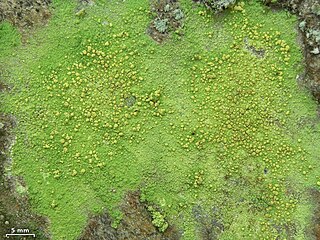
A lichen is a composite organism that arises from algae or cyanobacteria living among filaments of multiple fungi species in a mutualistic relationship. Lichens have properties different from those of their component organisms. They come in many colors, sizes, and forms and are sometimes plant-like, but are not plants. They may have tiny, leafless branches (fruticose); flat leaf-like structures (foliose); grow crust-like, adhering tightly to a surface (substrate) like a thick coat of paint (crustose); have a powder-like appearance (leprose); or other growth forms.
Xerosere is a plant succession that is limited by water availability. It includes the different stages in a xerarch succession. Xerarch succession of ecological communities originated in extremely dry situation such as sand deserts, sand dunes, salt deserts, rock deserts etc. A xerosere may include lithoseres and psammoseres.

Inks Lake State Park is a state park located in Burnet County, Texas, United States, next to Inks Lake on the Colorado River. The landscape of the park is hilly, with many cedar, live oak, prickly pear cacti, and yuccas. The ground is rocky, mainly consisting of gneiss rock.

Cyphellostereum is a genus of basidiolichens. Species produce white, somewhat cup-shaped fruit bodies on a thin film of green on soil which is the thallus. All Cyphellostereum species have nonamyloid spores and tissues, lack clamp connections, and also lack hymenial cystidia.

The Verrucariaceae are a family of mostly lichenised fungi in the order Verrucariales. The lichen-forming species, which comprise the vast majority of the family, have a wide variety of thallus forms, and include crustose (crust-like), foliose (bushy), and squamulose (scaly) representatives. Several characteristics of the spore-bearing structures, the ascomata, define the family, including their perithecioid form–more or less spherical or flask-shaped, with a single opening and otherwise completely enclosed by a wall. Squamulose members of the Verrucariaceae with simple ascospores, and without algae in the spore-bearing region are known as catapyrenioid lichens; there are more than 80 of these species. The family has several dozen lichenicolous (lichen-dwelling) examples, and a few genera that contain solely lichenicolous members. An unusually diverse variety of photobiont partners have been recorded, mostly green algae, but also brown algae and yellow-green algae.

The clavarioid fungi are a group of fungi in the Basidiomycota typically having erect, simple or branched basidiocarps that are formed on the ground, on decaying vegetation, or on dead wood. They are colloquially called club fungi and coral fungi.

Multiclavula is a genus of basidiolichens in the family Hydnaceae. The widespread genus contains 14 species.

Lepidostromatales is an order of fungi in the class Agaricomycetes. It is the only known order of basidiomycete fungi composed entirely of lichenized members. Morphologically, the fruiting bodies of all species are clavarioid. Six species are known, five of which were described within the span of 2007–2013. Due to its morphological similarity to the genus Multiclavula, its isolated phylogenetic position was not understood until quite recently. The photobionts that have been found in association with members of this group are not known to associate with any other types of lichenized fungi.
Lichens of the Sierra Nevada have been little studied. A lichen is a composite organism consisting of a fungus and a photosynthetic partner growing together in a symbiotic relationship.

Xanthoparmelia conspersa, commonly known as the peppered rock-shield, is a foliose lichen and the type species of genus Xanthoparmelia. It is widely distributed in temperate zones, and has been recorded from Japan, Europe, Africa, North America, and South America.

The Ecological regions of Quebec are regions with specific types of vegetation and climates as defined by the Quebec Ministry of Forests, Wildlife and Parks. Given the size of this huge province, there is wide variation from the temperate deciduous forests of the southwest to the arctic tundra of the extreme north.

Psilolechia lucida is a species of saxicolous lichen in the family Psilolechiaceae. It is widely distributed through the world, where it grows on natural and artificial rocky substrates in the shade, often in sheltered underhangs. It forms a greenish crust on the surface of its substrate.

Punctelia punctilla is a species of foliose lichen in the family Parmeliaceae. It is found in Africa, South America, and North America, where it grows on bark and on rocks. The main characteristics that distinguish Punctelia punctilla from other species of Punctelia are the presence of isidia on the thallus surface, a pale brown thallus undersurface, and the presence of lecanoric acid in the medulla.

Punctelia graminicola is a species of foliose (leafy) lichen in the family Parmeliaceae. It grows on rocks, and, less frequently, on bark in North America, South America, and East Africa. It has a blue-grey thallus measuring up to about 15 cm (6 in), covered with tiny pores called pseudocyphellae. Sometimes the lichen forms small lobes that project out from the surface. Fruiting bodies are uncommon in this species; if present, they resemble small cups with a brown internal disc measuring 3–10 mm (0.1–0.4 in) in diameter. A lookalike species, Punctelia hypoleucites, is not readily distinguishable from Punctelia graminicola by appearance or habitat alone; these species can only be reliably differentiated by examining the length of their conidia.

Cetrelia chicitae is a species of foliose lichen in the family Parmeliaceae. It is found in eastern Asia, North America, and Europe, where it grows on mossy rocks and tree trunks.
Porpidia seakensis is a species of crustose lichen in the family Lecideaceae. It is an endolithic species, meaning it grows inside the rocks, between the grains. Found only in Alaska, it was formally described as a new species in 2020 by British lichenologist Alan Fryday. The type specimen was collected in the Hoonah-Angoon Census Area, in Glacier Bay National Park. Here it was discovered growing on granitic rock in a woodland. The lichen is only known from this area, although it is locally common. Its preferred habitat is siliceous rocks and boulders in wooded areas that are open and well lit. The specific epithet seakensis uses the letters "seak" to refer to a standard abbreviation for southeast Alaska.
Multiclavula ichthyiformis is a species of terricolous (ground-dwelling) basidiolichen in the family Hygrophoraceae. Found in Costa Rica, it was formally described as a new species in 2007 by Matthew Nelsen, Robert Lücking, Loengrin Umaña, Marie Trest, and Susan Will-Wolf. The type collection was collected in the Macizo de la Muerte section of Tapantí National Park at an elevation of 2,700 m (8,900 ft). Here, in a disturbed high-altitude peat bog in a rainforest, it was found growing on the ground along a brook and a road bank.
Physconia rossica is a species of saxicolous (rock-dwelling), foliose lichen in the family Physciaceae. It is found in mountainous regions of the Russian Far East, Siberia, and Eastern Europe.
Xanthoparmelia perezdepazii is a species of saxicolous (rock-dwelling), foliose lichen in the family Parmeliaceae. It is found in the Canary Islands.
Verrucaria oulankaensis is a rare species of saxicolous (rock-dwelling) crustose lichen in the family Verrucariaceae. It is found in north-eastern Finland, where it occurs on calcareous rocks on river shores.












